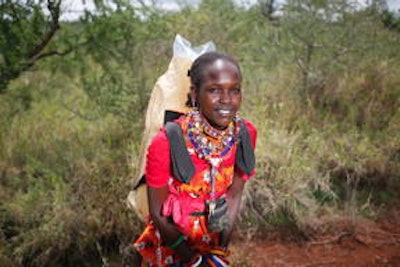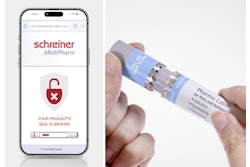
Water resources are becoming scare, according to the World Water Council, with 1.1 billion people lacking access to safe drinking water. Water.org reports that 3.575 million people die each year from a water-related disease. These figures point to the urgent need for clean water around the globe.
One source of help comes in the form of the PackH20 backpack, manufactured in Turkey and made by Greif, in development with Impact Economics. Made of a flexible polyethylene with a replaceable PET inner liner that may be purchased separately, some 3,000 backpacks are being used in Haiti, 1,000 in Guatemala, and 500 in Kenya and Uganda. The 1/5-in.-thick packs replace simple jerrycans and buckets that may have previously been used for gasoline or chemicals.
PackH2O is tough and resistant to puncture from sharp objects that can be encountered during the handling, storage, and water transport of the backpack. PackH2O is designed to transport 5 gallons or 20 liters of water. Women and children in developing nations carry household water an average of 3.5 miles/day. The PackH2O backpack shifts the weight of the water to the shoulders, relieving the pressure on the head and spine.
Field tests show the pack liner will last between 12 to 18 months if cared for correctly. Keeping the liner clean is what helps to keep contaminant levels low. That can be done by carefully removing the liner and placing it in the sun for 60 to 90 minutes. The use of soaps or detergents is not recommended. If a liner tears or is damaged, users may contact [email protected] for more information about obtaining new liners.
"Water risk is a significant issue for companies-but just getting water home is a daily hardship for more than one billion people worldwide," says Tony Somers, COO of Impact Economics. "Companies committed to sustainability know that solutions like PackH2O can help people live better lives and create better health outcomes."
Impact Economics partners with leading NGOs, foundations, and mission-oriented organizations to distribute PackH2O and to create micro-business opportunities by supporting local communities to assemble PackH2O where it is being used.
Here is one video showing the use of the Pack H20.
One source of help comes in the form of the PackH20 backpack, manufactured in Turkey and made by Greif, in development with Impact Economics. Made of a flexible polyethylene with a replaceable PET inner liner that may be purchased separately, some 3,000 backpacks are being used in Haiti, 1,000 in Guatemala, and 500 in Kenya and Uganda. The 1/5-in.-thick packs replace simple jerrycans and buckets that may have previously been used for gasoline or chemicals.
PackH2O is tough and resistant to puncture from sharp objects that can be encountered during the handling, storage, and water transport of the backpack. PackH2O is designed to transport 5 gallons or 20 liters of water. Women and children in developing nations carry household water an average of 3.5 miles/day. The PackH2O backpack shifts the weight of the water to the shoulders, relieving the pressure on the head and spine.
Field tests show the pack liner will last between 12 to 18 months if cared for correctly. Keeping the liner clean is what helps to keep contaminant levels low. That can be done by carefully removing the liner and placing it in the sun for 60 to 90 minutes. The use of soaps or detergents is not recommended. If a liner tears or is damaged, users may contact [email protected] for more information about obtaining new liners.
"Water risk is a significant issue for companies-but just getting water home is a daily hardship for more than one billion people worldwide," says Tony Somers, COO of Impact Economics. "Companies committed to sustainability know that solutions like PackH2O can help people live better lives and create better health outcomes."
Impact Economics partners with leading NGOs, foundations, and mission-oriented organizations to distribute PackH2O and to create micro-business opportunities by supporting local communities to assemble PackH2O where it is being used.
Here is one video showing the use of the Pack H20.





















